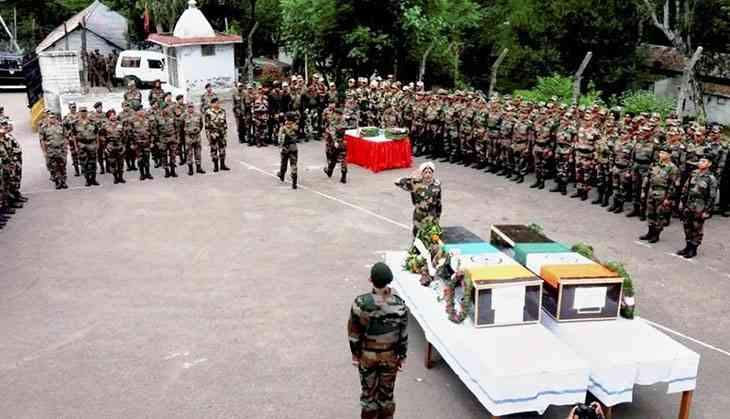Poonch mutilation: Did soldiers walk into a trap despite intelligence inputs?

Did India's joint patrol party walk into a death trap?
The Border Action Team of the Pakistani Army, which is alleged to have carried out the ghastly mutilation of two Indian soldiers, may have planned the attack in advance.
It is understood that intelligence agencies had tipped off the security forces to be vigilant after intercepting chatter from across the border, which pointed to the possibility of such an attack.
This is the third such attack since October 2016, where bodies of security personnel have been found mutilated.
While Pakistan continues to deny that its army had any role to play in the barbaric attack, security agencies are not ruling out the possibility of the Pakistani Army using mercenaries or Jihadis to carry out the ambush and subsequent decapitation of the bodies of Naib Subedar Paramjit Singh and Head Constable Prem Sagar.
The attack could not have been carried out without the complicity of the Pakistani Army, they insist.
According to reports, post the attack, the commanders have not just changed the deployment in the three-tier counter infiltration grid in the Kashmir Valley, but have also been instructed to take multiple measures to avoid casualties. As Pakistan tries to continue to push infiltrators into Kashmir, more than 50 terror camps have reportedly again come up on the other side of the Line of Control.
How it happened
On Monday, a joint patrol party, comprising of personnel from the Border Security Force and the Indian Army in Krishna Ghati of the Poonch sector, reportedly out on a routine patrol to check explosives, had come under attack from machine gun fire and rocket-propelled grenades from across the border, leading it to seek cover.
The members of the party were then ambushed around 250 metres inside Indian territory, suggesting that the attack was carefully planned in advance.
The blood trail on the spot of the attack suggests that the attackers went back to the other side of the LoC.
The government says it has given Pakistan actionable evidence on the involvement of its army in the barbaric attack.
Retaliation to assault on Pak posts?
There is a belief that the attack could have been planned in retaliation to the assault on Pakistani posts by the Indian security forces. Reports say the Pakistani Army, which has been aggressively pushing terror operatives to disrupt peace in Kashmir, and engaging in ceasefire violations on the LoC, has come under pressure from sustained heavy artillery fire from the Indian forces, which has resulted in considerable casualties in April.
While Pakistan has not owned up to the incident, reports indicate that seven to 10 Pakistani Army personnel may have perished in the firing.
Pakistani Army chief Qamar Javed Bajwa, who is trying to come out of the shadows of his predecessor, General Raheel Sharif, had visited Pakistani posts in Haji Pir, not very far from where the ambush took place in the Krishna Ghati sector.
A report in the Indian Express says the order to carry out the attack may have come from Bajwa himself, prodded by local commanders, whose units are at the receiving end of India's response to continued cross border firing.
Govt not mincing words
Meanwhile, the Government of India has not minced words. Pakistani High Commissioner Abdul Basit has been told that the government has proof that the act was carried out by Pakistani Army personnel. Basit was summoned to South Block by Foreign Secretary S Jaishankar.
Calling it a “strong act of provocation”, the country's top diplomat demanded that Pakistan “take immediate action against its soldiers and commanders responsible for this heinous act”.
MEA spokesperson Gopal Baglay says “actionable evidence” has been provided to Pakistan.
Basit has expectedly denied the Pakistani Army's involvement. Earlier, ISPR, the media wing of the Pakistani Army, too had denied its role in the incident, and claimed that it shall never disrespect a soldier, “even Indian”.
However, the Indian government is convinced of the Pakistani Army's complicity. Basit was told that cover fire and the trail of blood were clear giveaways.
“It was significant that the attack was preceded by covering fire from Pakistani posts in the Battal sector (in the vicinity of the village Battal). Blood samples of the Indian soldiers that have been collected and the trail of blood on Roza Nala clearly shows the killers returned across the Line of Control,” the MEA said in a statement on the meeting.
“We have proof it was carried out by the Pakistan Army. We have demanded from Pakistan that whoever from their army was behind this incident be punished," MEA spokesperson Baglay said.
History of BAT attacks and India's responses
The BAT has a history of carrying out such attacks to provoke Indian security forces.
Lt General (Retd.) Syed Ata Hasnain, who served as the Corps Commander in Kashmir, had, in a 2013 article, explained BAT's modus operandi.
“Border Action Teams comprise a mix of Pakistan Army regulars, Pakistan Special Forces elements and high profile terrorists (Jihadis) who are trained to cross the LoC to execute raids on Indian picquets, ambushes and patrol parties or logistics elements. Beheading has been one of the modus operandi adopted by these teams to cause scare and impose immense caution on their targets,” he had written.
Security forces are known to quietly respond to such provocations, like in November 2016, when the forces are reported to have killed multiple Pakistani Army personnel in retaliation to the mutilation of the body of a sepoy in Machil sector.
The attack has put the Prime Minister Narendra Modi-led NDA government in a tough spot, as the Opposition demands answers.
First published: 3 May 2017, 21:29 IST
